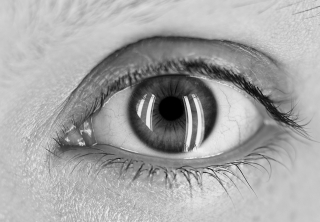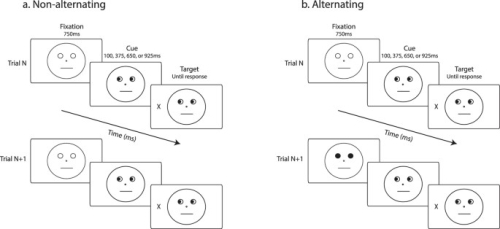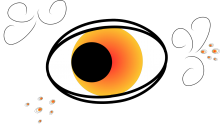Eye-to-eye contact is infrequent but shapes our social behavior
Check out Florence Mayrand's recently published paper that was featured on the tobii website: Eye-to-eye contact is infrequent but shapes our social behavior!
Mayrand, F., Capozzi, F. & Ristic, J. A dual mobile eye tracking study on natural eye contact during live interactions. Sci Rep 13, 11385 (2023).


Face masks impair recognition of emotions
Dr McCrackin, Dr Ristic and the team from the ASC group investigated how facial emotion recognition is affected by mask wearing. We asked participants to identify happy, angry, fearful, sad, surprised, disgusted, and neutral emotional expressions from masked and unmasked face images. Participants also completed two questionnaires to assess if the impact of masks on emotion recognition was related to self-reported social competence and personality traits.
We showed that recognition of all basic facial expressions is strikingly impacted by face masks. Little variation was observed across individuals. Specifically while those with lower social competence had lower emotion recognition for unmasked faces, those with higher trait agreeableness and lower trait extraversion have better emotion recognition for masked faces. Thus, the pandemic has implications for human social communication by hindering our nonverbal social communication.
Recent research from ASC group shows that wearing face masks impairs human social communication (McCrackin, S.D., Capozzi, F., Mayrand, F., Ristic, J. (2022). Face Masks Impair Basic Emotion Recognition. Social Psychology, https://doi.org/10.1027/1864-9335/a000470).
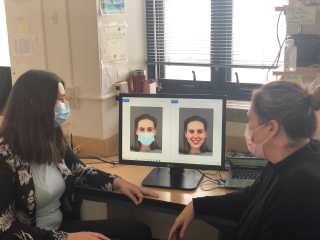
Social Orienting of Attention
Dr. Jelena Ristic and Dr. Francesca Capozzi co-authored an opinion paper which was published in Visual Cognition. In this paper, Ristic and Capozzi argue that both the attribution of mental states and the operation of domain-general attentional processes contribute to social orienting behaviours like perspective-taking and gaze following. Reframing a debate that has opposed these processes for a long time, Ristic and Capozzi discuss how they might interact to jointly influence social behaviors.
Capozzi, F. & Ristic, J. (2020) Attention AND mentalizing? Reframing a debate on social orienting of attention. Visual Cognition. DOI: 10.1080/13506285.2020.1725206
Attention and Accurate Impression Formation
We often form an impression of others at “first glance.” Despite this notion, the role of attention in impression formation has not been scientifically investigated. Recent research from the A&SC lab examines the relationship between attention and accuracy in impression formation.
Dr Francesca Capozzi, working in collaboration with Dr. Jelena Ristic and Dr. Lauren Human, revealed that paying more attention to others was related to an increased ability to understand their personality. These results suggest that attention promotes social adaptation by supporting accurate social perception.
Capozzi, F., Human, L. & Ristic, J. (2019). Attention promotes accurate impression formation. Journal of Personality. Advanced online publication. DOI: 10.1111/jopy.12509
Gaze behaviour in complex social interactions
Can gaze behavior reveal the leader during real-world group interactions? Recent research from the A&SC lab attempts to answer this question.
Dr. Francesca Capozzi worked to develop a new methodology that combines cognitive methods, social psychology theory, and computer science technology to monitor gaze behaviors in natural group interactions and reveal who the group leader is.
Capozzi, F., Beyan, C., Pierro, A., Koul, A., Murino, V., Livi, S., Bayliss, A. P., Ristic, J. & Becchio, C. (2019). Tracking the leader: Gaze behaviour in group interactions. iScience, 16, 242-249. DOI: 10.1016/j.sci.2019.05.035
Attention is not automatically biased towards faces
It is commonly accepted that human attention is spontaneously biased towards faces and eyes; however, this has not been investigated systematically. Recent work from the A&SC lab investigates this assumption.
Effie Pereira worked in collaboration with Dr. Jelena Ristic and Dr. Elina Birmingham to explore the systems of cognitive attention with laboratory tests. Findings revealed that attention to social information is likely only engaged when it’s relevant to our task, rather than being “on” for faces all the time.
Pereira, E. J., Birmingham, E. & Ristic, J. (2019). The eyes do not have it after all? Attention is not automatically biased towards faces and eyes. Psychological research, 16 (12), 1-17. DOI: 10.1007/s00426-018-1130-4
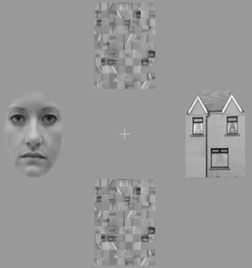
How attention gates social interactions
Social interactions are at the core of human social life. However, we selectively choose our social partners and do not engage in all available opportunities for social encounters. What are the social and cognitive processes that support the selection of social interactions among the myriad of potential ones?
In their review paper, Dr. Francesca Capozzi and Dr. Jelena Ristic show that attentional systems play an important role in guiding the selection of our social interactions. Supported by both classic and emerging literature on how human attention operates in social and interactive contexts, Capozzi and Ristic show how attention to other people is modulated by a complex interplay between social perception, interpretation of others’ mental states and communicative intentions, and evaluation of who our interactive partners are. For example, is the person we encounter looking at something of interest? Is this person a friend or a foe? Depending on how we answer these questions, we will pay or not pay attention to that person – thus determining whether or not we will engage in a social interaction with them.
This is a new and integrated perspective on human social attention that exposes it as a complex and heterogeneous ability that is critical to one of the core aspects of human life—the selection and management our social interactions.
Capozzi, F. & Ristic, J. (2018). How attention gates social interactions. Annals of the New York Academy of Sciences, advance online publication, (1426), 179-198. DOI: 10.1111/nyas.13854


Smile! Social reward drives attention
Recent work shows that experiencing socially rewarding acts such as praise or positive feedback during interactions can shape which events we pay attention to later on.
Dr. Dana Hayward, Effie Pereira, Dr. Ross Otto, and Dr. Jelena Ristic reported that after participating in a group social interaction, participants paid more attention to events that received social reward than events that received no reward. Furthermore, individuals with higher social intelligence reaped more benefits from the social interaction with larger social attentional effects.
These findings provide one of the first insights into how complex social signals available in the environment influence our cognition and behavior.
Hayward, D. A., Pereira, E. J., Otto, A. R. & Ristic, J. (2017). Smile! Social reward drives attention. Journal of Experimental Psychology: Human Perception and Performance, 44 (2), 206-214. DOI: 10.1037/xhp0000459

Reading the language of eyes
Researchers have long been puzzled as to why research studies kept finding normative eye gaze reading abilities in individuals with disorders of social behavior, such as autism. After all, reduced social ability should be connected with how we extract social information from eye gaze, a powerful social cue.
Dr. Dana Hayward and Dr. Jelena Ristic hypothesized that instead of accessing the social content available from gaze cues directly, individuals with lowered social competence extract that information by paying attention to perceptual transients associated with shifts in gaze position (e.g., pupil motion).
Hayward and Ristic measured social competence and gaze following in 132 healthy volunteers, separating the contribution of social and perceptual processing on attentional behavior. The results indicated that more socially competent participants prioritized attending to social information conveyed by eye gaze compared to less socially competent individuals who prioritized attending to perceptual changes in gaze.
These results expose the links between subtle differences in stimulus perception and large scale social outcomes. They further suggest that understanding how individuals with autism access social information conveyed by social cues by eye gaze will be beneficial in further unravelling the mysteries of this prevalent disorder.
Hayward, D. A. & Ristic, J. (2017). Feature-and motion-based gaze cuing is linked with reduced social competence. Scientific Reports, 7 (1). DOI: 10.1038/srep44221




